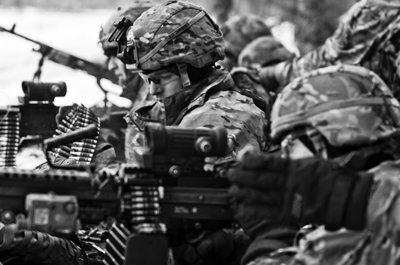The nature of close combat in land operations is unique. Combatants routinely come face-to-face with one another in large numbers in a wide variety of operational environments comprising all types of terrain. When other means fail to drive enemy forces from their positions, Army forces close with and destroy or capture them. The outcome of battles and engagements depends on the ability of Army forces to close with enemy forces and prevail in close combat. Close combat is warfare carried out on land in a direct-fire fight, supported by direct and indirect fires and other assets. Units involved in close combat employ direct fire weapons supported by indirect fire, air-delivered fires, and nonlethal engagement means. Units in close combat defeat or destroy enemy forces and seize and retain ground. Close combat at lower echelons contains many more interactions between friendly and enemy forces than any other form of combat.

Iron Troop Soldiers with 3rd Squadron, 2nd Cavalry Regiment, stationed out of Vilseck, Germany, supress the enemy with an assault attack during a live fire exercise at Tapa Training Area in Estonia, March 8-11, 2016. (Photo by U.S. Army Staff Sgt. Steven M. Colvin/Released)
Close combat is most often linked to difficult terrain where enemies seek to negate friendly advantages in technology and weapon capabilities. Urban terrain represents one of the most likely close combat challenges. The complexity of urban terrain and the density of noncombatants reduce the effectiveness of advanced sensors and long-range weapons. Operations in large, densely populated areas require special considerations. From a planning perspective, commanders view cities as both topographic features and a dynamic system of varying operational entities containing hostile forces, local populations, and infrastructure.
Effective close combat relies on lethality informed by a high degree of situational understanding across multiple domains. The capacity for physical destruction is the foundation of all other military capabilities, and it is building block of military operations. Army formations are organized, equipped, and trained to employ lethal capabilities in a wide range of conditions. The demonstrated lethality of Army forces provides the credibility essential to deterring adversaries and assuring allies and partners.
An inherent, complementary relationship exists between using lethal force and applying military capabilities for nonlethal purposes. In wartime, each situation requires a different mix of violence and constraint. Lethal and nonlethal actions used together complement each other and create multiple dilemmas for opponents. During operations short of armed conflict, the lethality implicit in Army forces enables their performance of other tasks effectively with minimal adversary interference.
Tactics
Tactics is the employment and ordered arrangement of forces in relation to each other. Through tactics, commanders use combat power to accomplish missions. The tactical-level commander uses combat power in battles, engagements, and small-unit actions.
The tactical level of war is the level of war at which battles and engagements are planned and executed to achieve military objectives assigned to tactical units or task forces (JP 3-0). Activities at this level focus on the ordered arrangement and maneuver of combat elements in relation to each other and to the enemy to achieve combat objectives. It is important to understand tactics within the context of the levels of war. The strategic and operational levels provide the context for tactical operations. Without this context, tactical operations are reduced to a series of disconnected and unfocused actions. Read more about Tactics…
 This article is an extract from "SUTS3: The Small Unit Tactics SMARTbook, 3rd Ed. (Planning & Conducting Tactical Operations)" by The Lightning Press. Download a free PDF sample and learn more at: SUTS3: The Small Unit Tactics SMARTbook, 3rd Ed. (Planning & Conducting Tactical Operations).
This article is an extract from "SUTS3: The Small Unit Tactics SMARTbook, 3rd Ed. (Planning & Conducting Tactical Operations)" by The Lightning Press. Download a free PDF sample and learn more at: SUTS3: The Small Unit Tactics SMARTbook, 3rd Ed. (Planning & Conducting Tactical Operations).
Browse additional military doctrine articles in our SMARTnews Blog & Resource Center.
About The Lightning Press SMARTbooks. Recognized as a “whole of government” doctrinal reference standard by military, national security and government professionals around the world, SMARTbooks comprise a comprehensive professional library. SMARTbooks can be used as quick reference guides during operations, as study guides at education and professional development courses, and as lesson plans and checklists in support of training. Browse our collection of Military Reference SMARTbooks to learn more.













































